1995 CADILLAC SEVILLE service
[x] Cancel search: servicePage 316 of 410
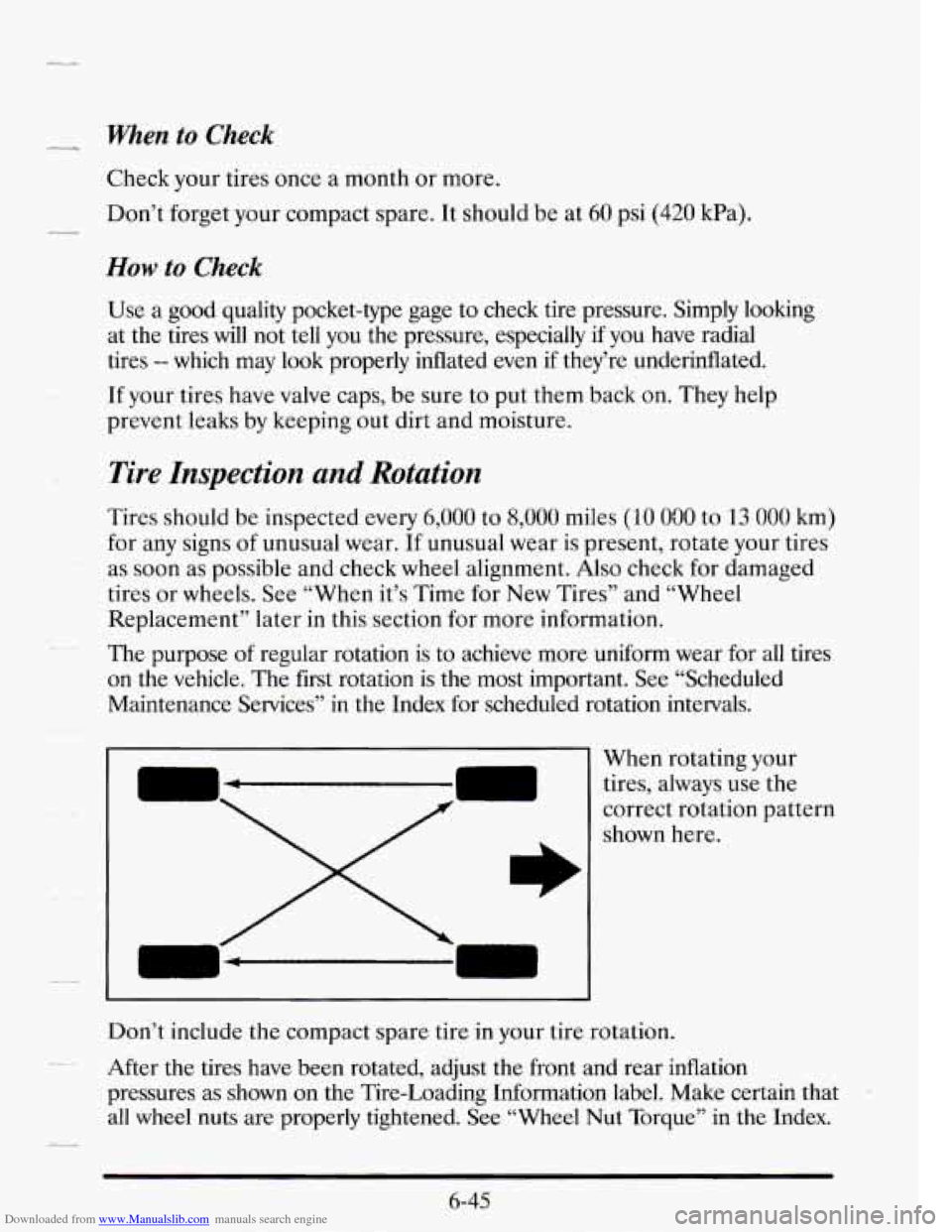
Downloaded from www.Manualslib.com manuals search engine When to Check
- -c
- --
c-
Check your tires once a month or more.
Don’t forget your compact spare. It should be at
60 psi (420 kPa).
How to Check
Use a good quality pocket-type gage to check tire pressure. Simply looking
at the tires will not tell you the pressure, especially if you have radial
tires
-- which may look properly inflated even if they’re underinflated.
If your tires have valve caps, be sure to put them back on. They help
prevent leaks by keeping out dirt and moisture.
Tire Inspection and Rotation
Tires should be inspected every 6,000 to 8,000 miles (10 030 to 13 000 km)
for any signs
of unusual wear. If unusual wear is present, rotate your tires
as
soon as possible and check wheel alignment. Also check for damaged
tires or wheels. See “When it’s Time for New Tires” and “Wheel
Replacement’’ later in this section
for more information.
The purpose of regular rotation is to achieve more uniform wear for all tires
on the vehicle. The first rotation is the most important. See “Scheduled
Maintenance Services” in the Index for scheduled rotation intervals.
When rotating your
tires, always use the
correct rotation pattern
shown here.
Don’t include the compact spare tire in your tire rotation.
After the tires have been rotated, adjust the front and rear inflation
pressures as shown
on the Tire-Loading Information label. Make certain that
all wheel nuts are properly tightened. See “Wheel
Nut Torque” in the Index.
6-45
Page 318 of 410
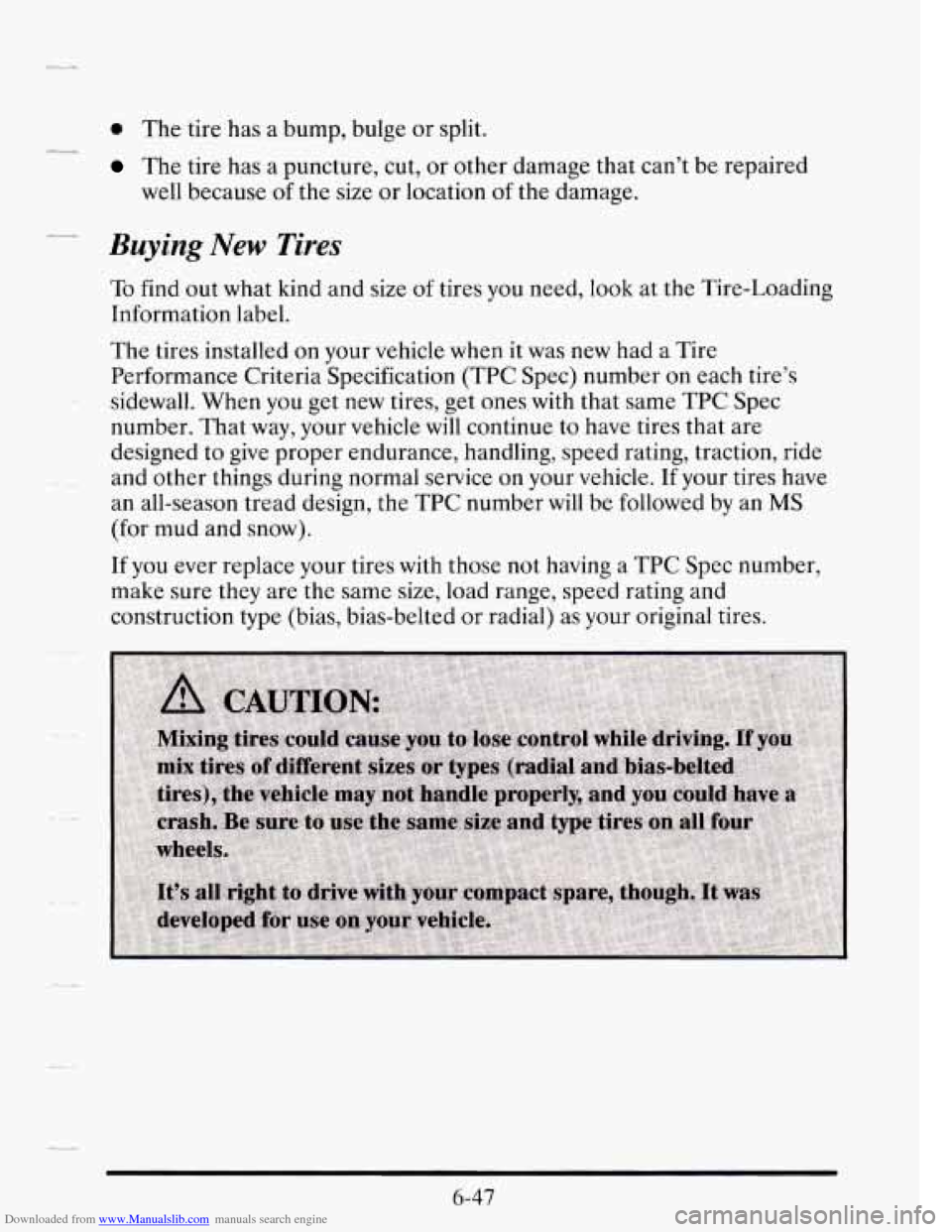
Downloaded from www.Manualslib.com manuals search engine 0 The tire has a bump, bulge or split.
The tire has a puncture, cut, or other damage that can’t be repaired
well because
of the size or location of the damage.
Buying New Tires
To find out what kind and size of tires you need, look at the Tire-Loading
Information label.
The tires installed on your vehicle when it was new had a Tire
Performance Criteria Specification (TPC Spec) number on each tire’s
sidewall. When you get new tires, get ones with that same TPC Spec
number. That way, your vehicle
will continue to have tires that are
designed to give proper endurance, handling, speed rating, traction, ride
and other things during normal service on your vehicle. If your tires have
an all-season tread design, the TPC number
will be followed by an MS
(for mud and snow).
If
you ever replace your tires with those not having a TPC Spec number,
make sure they are the same size, load range, speed rating and
construction type (bias, bias-belted
or radial) as your original tires.
6-47
Page 319 of 410
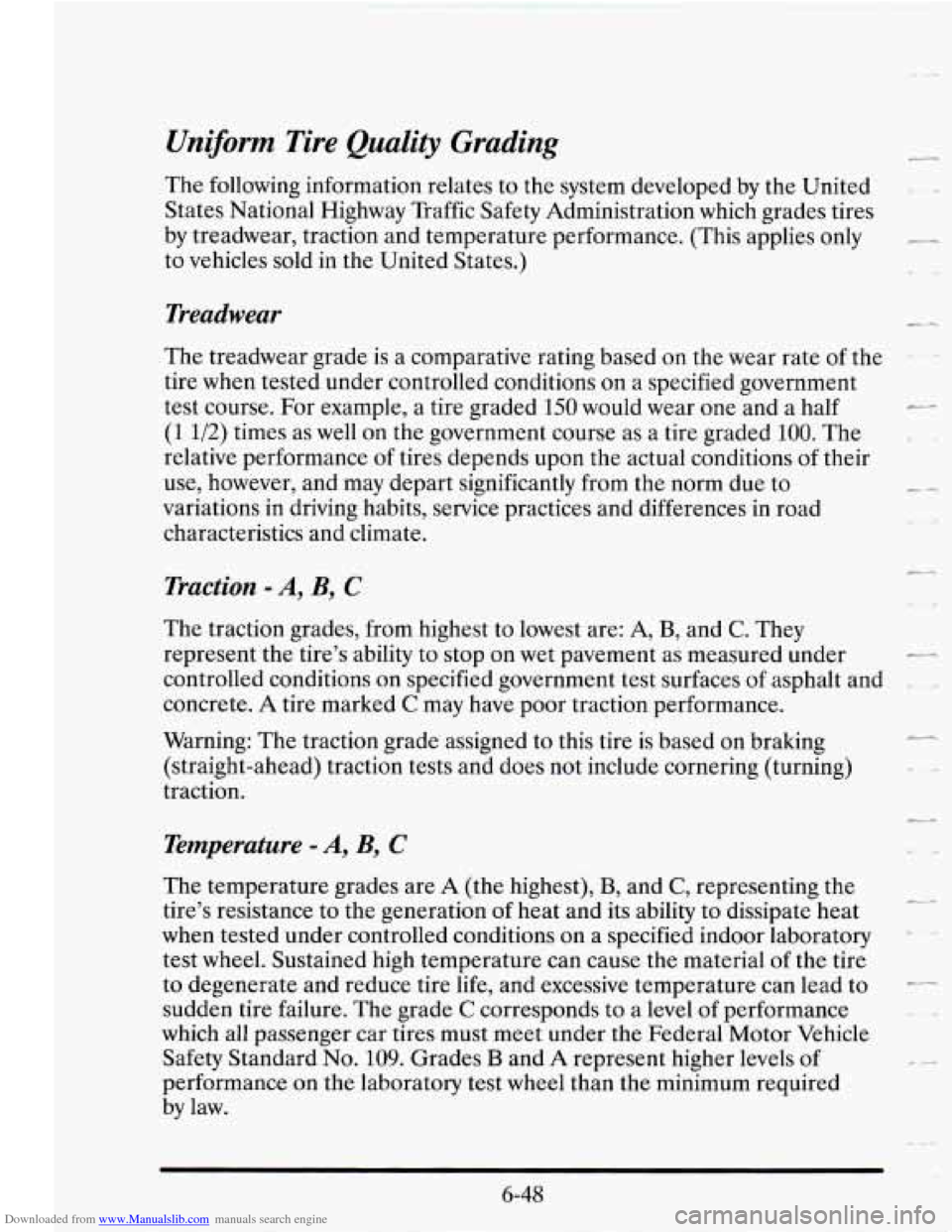
Downloaded from www.Manualslib.com manuals search engine Uniform Tire Quality Grading
The following information relates to the system developed by the United
States National Highway Traffic Safety Administration which grades tires
by treadwear, traction and temperature performance. (This applies only
to vehicles sold
in the United States.)
Treadwear
The treadwear grade is a comparative rating based on the wear rate of the
tire when tested under controlled conditions on a specified government
test course. For example,
a tire graded 150 would wear one and a half
(1 1/2) times as well on the government course as a tire graded 100. The
relative performance
of tires depends upon the actual conditions of their
use, however, and may depart significantly from the norm due to
variations in driving habits, service practices and differences in road
characteristics and climate.
Traction - A, B, C
The traction grades, from highest to lowest are: A, B, and C. They
represent the tire’s ability to stop on wet pavement as measured under
c_
controlled conditions on specified government test surfaces of asphalt and
concrete.
A tire marked C may have poor traction performance.
-
L-
Warning: The traction grade assigned to this tire is based on braking
(straight-ahead) traction tests and does not include cornering (turning)
traction.
Temperature - A, B, C
The temperature grades are A (the highest), B, and C, representing the
tire’s resistance to the generation
of heat and its ability to dissipate heat
when tested under controlled conditions
on a specified indoor laboratory .
test wheel. Sustained high temperature can cause the material of the tire
to degenerate and reduce tire life, and excessive temperature can lead
to -
sudden tire failure. The grade C corresponds to a level of performance
which all passenger car tires must meet under the Federal Motor Vehicle
Safety Standard
No. 109. Grades B and A represent higher levels of
performance on the laboratory test wheel than the minimum required
by law.
6-48
Page 330 of 410
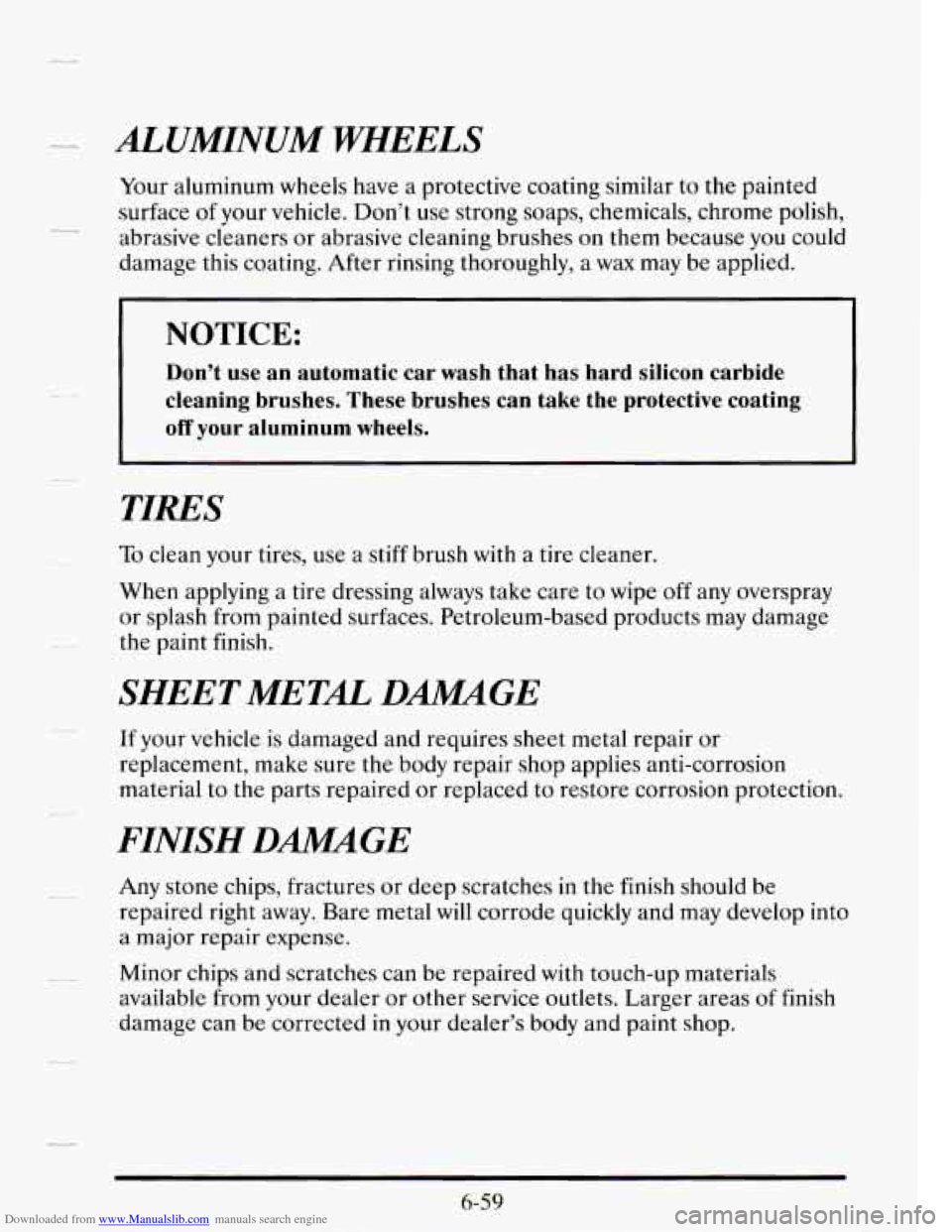
Downloaded from www.Manualslib.com manuals search engine L-
ci
ALUMINUM WHEELS
Your aluminum wheels have a protective coating similar to the painted
surface
of your vehicle. Don’t use strong soaps, chemicals, chrome polish,
abrasive cleaners or abrasive cleaning brushes on them because
you could
damage this coating. After rinsing thoroughly, a wax may be applied.
NOTICE:
Don’t use an automatic car wash that has hard silicon carbide
cleaning brushes. These brushes can take the protective coating
off your aluminum wheels.
TIRES
To clean your tires, use a stiff brush with a tire cleaner.
When applying a tire dressing always take care to wipe
off any overspray
or splash from painted surfaces. Petroleum-based products may damage
the paint finish.
SHEETMETAL DMGE
If your vehicle is damaged and requires sheet metal repair or
replacement, make sure the body repair shop applies anti-corrosion
material to the parts repaired or replaced to restore corrosion protection.
FINISH DWGE
Any stone chips, fractures or deep scratches in the finish should be
repaired right away. Bare metal
will corrode quickly and may develop into
a major repair expense.
Minor chips and scratches can be repaired with touch-up materials
available from your dealer or other service outlets. Larger areas
of finish
damage can be corrected in your dealer’s body and paint shop.
Page 333 of 410
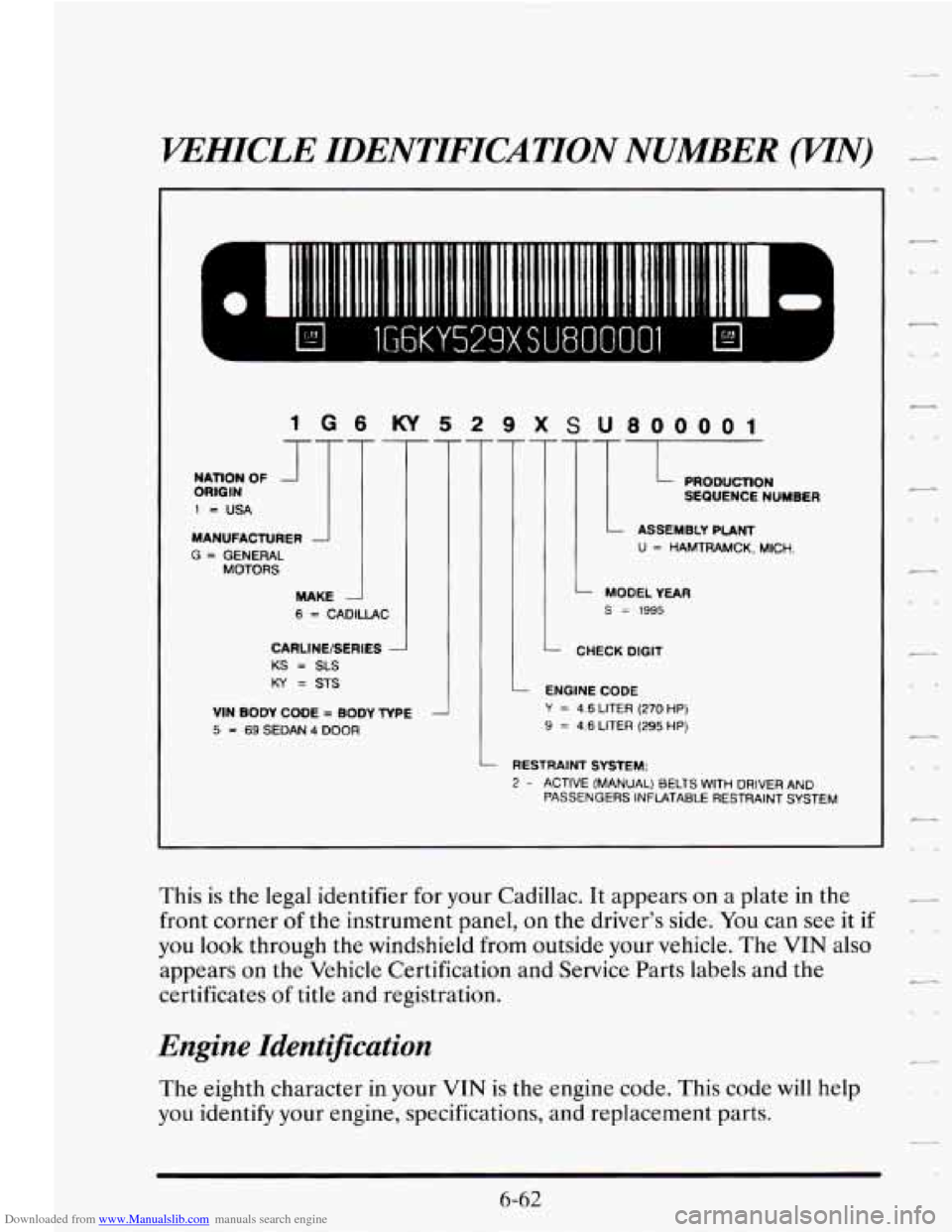
Downloaded from www.Manualslib.com manuals search engine W3HICLE IDENTIFICATION NUMBER (WN)
lG6KY529XSU800001 A
1 G 6 KY 5 2 9 X S U800001
7
-
NATION OF ORIGIN
1 E. USA
MANUFACTURER
G = GENERAL MOTORS MAKE
-
6 = CADILLAC
CARLINEISERIES -
KS = SLS
KY = STS
VIN BODY CODE = BODY TVPE -
5 = 69 SEDAN 4 DOOR
r -TI PRODUCTION
SEQUENCE NUYBCR
ASSEMBLY PLANT
U = HAMTRAMCK. MlCH
- MODELYEAR S = 1995
- CHECK DIGIT
- ENGINE CODE
Y = 4.6 LITER (270 HP)
9 = 4.6 LITER (295 HP)
RESTRAINT SYSTEM:
2 - ACTIVE (MANUAL) BELTS WITH DRIVER AND
PASSENGERS INFLATABLE RESTRAINT SYSTEM
This is the legal identifier for your Cadillac. It appears on a plate in the
front corner
of the instrument panel, on the driver’s side. You can see it if
you
look through the windshield from outside your vehicle. The VIN also
appears on the Vehicle Certification and Service Parts labels and the
certificates
of title and registration.
Engine Identiflcation
The eighth character in your VIN is the engine code. This code will help
you identify your engine, specifications, and replacement parts.
Page 337 of 410

Downloaded from www.Manualslib.com manuals search engine Mai FuseslRelay Center
The maxi fuse and relays are located next to the engine compartment fuse
block.
If a maxi fuse should blow, have your vehicle serviced by your
Cadillac dealer immediately.
OlsfA , , SIR I , PCM (ION) I I INJ I I INJ , I ION 1 , ,FUEL PUMP]
I FUSE CENTER IDENTIF GATION I
Engine Compartment Fuse Block
FUSE I USAGE I I
DISTR I Ignition Control Module I I
SIR I Sensing & Diagnostic Module I
PCM (IGN) I Powertrain Control Module (PCM); PASS-Key% Decoder Module I
INJ 1,4,6 and 7 Fuel Injectors
INJ
2,3,5 and 8 Fuel Injectors
IGN 1 A/C Refrigerant Pressure Switch; Transaxle Range Switch;
Stop/BTSI/Cruise Brake Switch; Instrument Panel Cluster; Keyless
Entry Module; DiagnosticEnergy Reserve Module (Derm);
Cornering Lamps; Turn/Hazard Switch Assy; Chime Module;
Headlamp Switch; Twilight SentineUDRL Module
6-66
1
IC--
L-
.*
Page 342 of 410
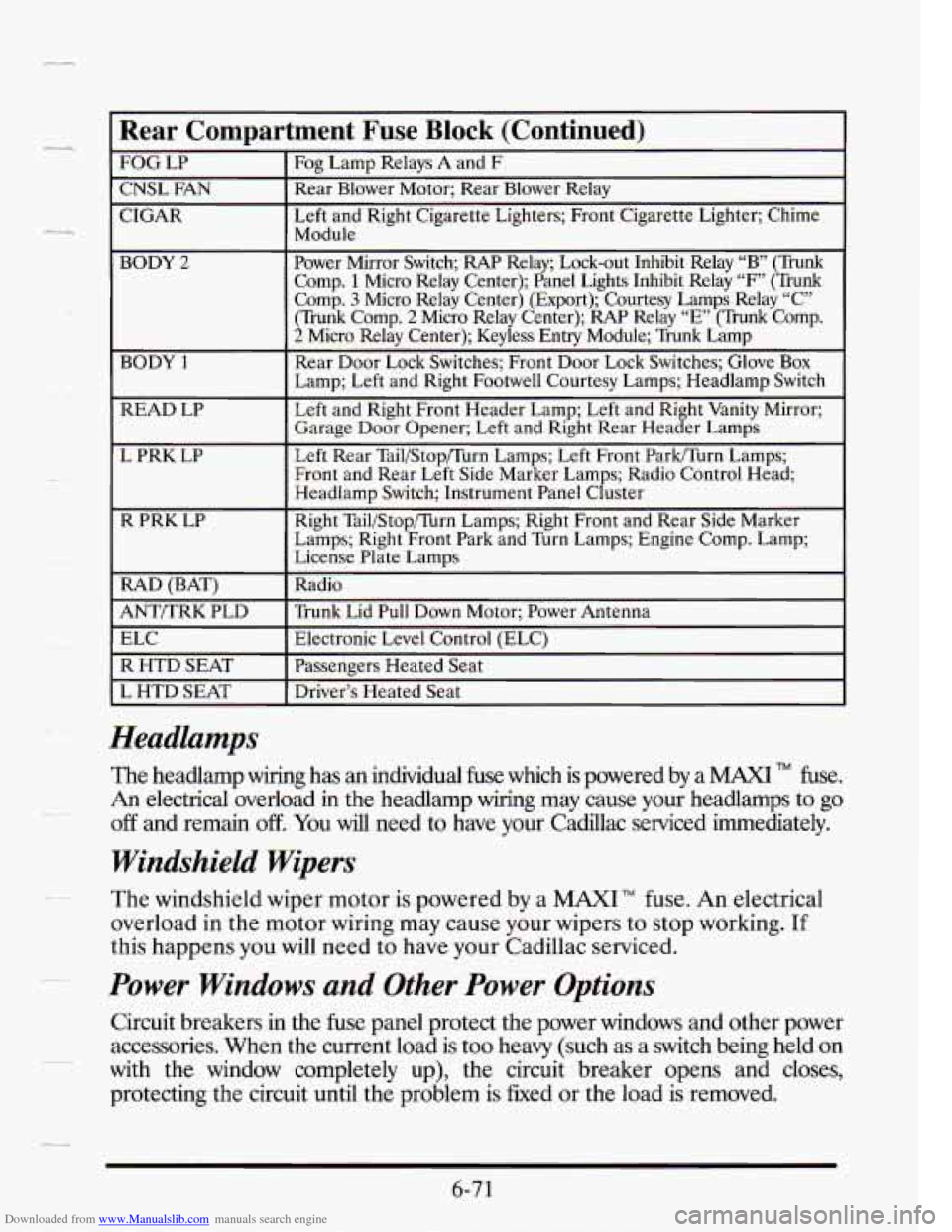
Downloaded from www.Manualslib.com manuals search engine wmpartment Fuse Block (Continued) 1
c-
I FOG LP
F
CNSL FAN
CIGAR
BODY
2
BODY 1
READ LP
L PRK LP
R PRK LP
RAD (BAT)
ANT/TRK PLD
ELC
R HTD
SEAT
L HTD SEAT r
Headlamps
Fog Lamp Relays A and F
Rear Blower Motor; Rear Blower Relay
Left and Right Cigarette Lighters; Front Cigarette Lighter; Chime
Module
Power Mirror Switch;
RAP Relay; Lock-out Inhibit Relay “B” (Trunk
Comp.
1 Micro Relay Center ; Panel Lights Inhibit Relay “F” (Trunk
Comp.
3 Micro Relay Center 1 (Export); Courtesy Lamps Relay “C”
(Trunk Comp.
2 Micro Relay Center); RAP Relay “E’ (Trunk Comp.
2 Micro Relay Center); Keyless Entry Module; Trunk Lamp
Rear Door Lock Switches; Front Door Lock Switches; Glove
Box
Lamp; Left and Right Footwell Courtesy Lamps; Headlamp Switch .- -
Left and Right Front Header Lamp; Left and Right Vanity Mirror;
Garage Door Opener; Left and Right Rear Header Lamps
- -
Left Rear Tail/Stop/Turn Lamps; Left Front Parkflurn Lamps;
Front and Rear Left Side Marker Lamps; Radio Control Head;
Headlamp Switch; Instrument Panel Cluster
Right Tail/Stop/Turn Lamps; Right Front and Rear Side Marker
Lamps; Right Front Park and Turn Lamps; Engine Comp. Lamp;
License Plate Lamps
Radio
Trunk Lid Pull Down Motor; Power Antenna
Electronic Level Control (ELC)
Passengers Heated Seat
Driver’s Heated Seat
The headlamp wiring has an individual fuse which is powered by a MAXI TM fuse.
An electrical overload in the headlamp wiring may cause your headlamps to go
off and remain off. You will need to have your Cadillac serviced immediately.
Windshield Wipers
The windshield wiper motor is powered by a MAXI fuse. An electrical
overload in the motor wiring may cause your wipers to stop working.
If
this happens you will need to have your Cadillac serviced.
Power Windows and Other Power Options
Circuit breakers in the fuse panel protect the power windows and other power
accessories. When the current load is too heavy (such as a switch being held on
with the window completely up), the circuit breaker opens and closes,
protecting the circuit until the problem is fixed or the load is removed.
6-71
Page 355 of 410
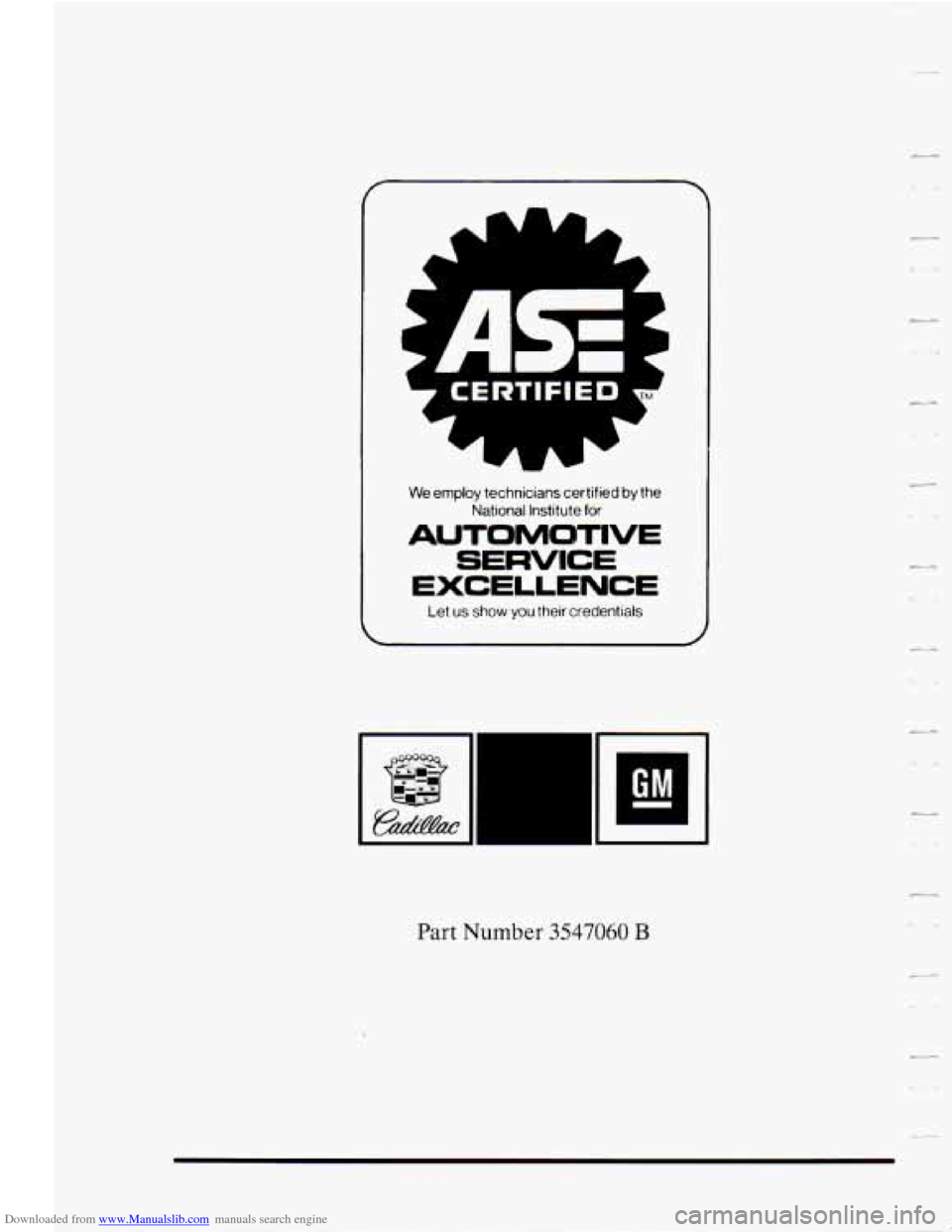
Downloaded from www.Manualslib.com manuals search engine We employ technicians certified by the
National Institute
for
AUTOMOTIVE
SERVICE
EXCELLENCE
Let us show you their credentrals
/
Part Number 3547060 B